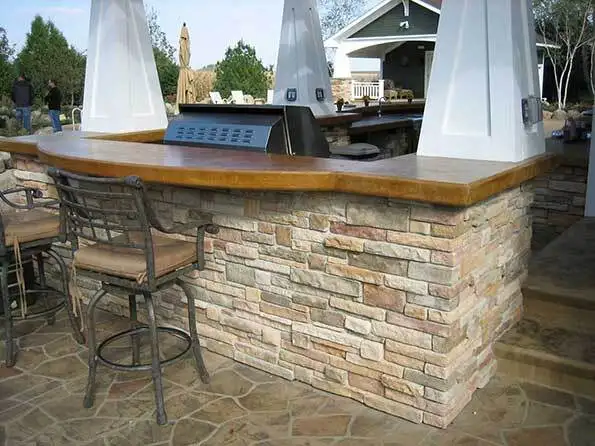Concrete Countertop Ideas
Concrete is a popular and trendy materials choice for countertops. Concrete countertops are a premium alternative to marble, granite, and quartz. Concrete countertops have many advantaged and disadvantages versus more traditional materials. If planned and installed properly, a concrete countertop is a valuable addition to a kitchen or bathroom.


Other Materials
Concrete countertops compete against a wide range of traditional materials. While none of these are truly bad choices, few of these materials can fully match concrete. The most direct competition for concrete countertops are quartz countertops, granite countertops, and marble countertops. Each of these stone materials posses a high degree of durability and classic aesthetic appeal. Often, concrete countertops are made to mimic these natural and engineered stone options. On the other side, concrete countertops are far superior to less costly options such as laminate, tile, and synthetic countertops.
Customization
This is the biggest selling point for concrete countertops. If you have concrete countertop ideas, a skilled contractor can almost certainly make it happen. Concrete countertop colors and combinations are near infinite. Shapes are also only limited by the concrete countertops forms. As long as the countertop is structurally supported, there is essentially no limit to the size or layout of countertop. Further customization is possible with inlays and embedded materials.


Durability
Concrete countertops are very durable, especially when compared to lesser materials. As one would expect with concrete, they have excellent compressive strength and resist abrasion very well. If properly supported and reinforced, a concrete countertop should last for decades. Fibers are a common inclusion in concrete countertops. Glass fibers are most common with concrete countertops because they reduce cracking and increase flexural strength.
Cost
Cost can be a benefit and a hindrance for concrete countertops. The most basic concrete countertop designs are generally cost competitive with materials like granite and quartz. However, the wide degree of customization and high labor requirements for creating and installing concrete countertops can rapidly increase that cost. All of this means that, while concrete countertops can be made with a reasonable cost, they should not be seen as the frugal option.
Speed
Concrete countertops are almost always custom made. Few suppliers or contractors will have concrete countertops ready in stock. This means a concrete countertop will not be installed as quickly as a premanufactured option of another material. Assume a turnaround time of at least a few weeks. If you are able to plan ahead, this usually is not an issue. But rush jobs should not rely on getting a concrete countertop.
Maintenance
Sealer is a must for concrete countertops. Without proper sealer and wax, concrete countertops are very susceptible to staining. Sealers are also not typically heat resistant, so exposure to high heat is not suggested unless the concrete countertop is unsealed. If the sealer is maintained, there is no reason a concrete countertop can’t last.

Concrete Countertop Design
There are two major design motifs for concrete countertops: plain concrete countertops and colored concrete countertops. By selecting one of these two options, you are deciding the general look and feel. Plain concrete countertops rely on the natural color and appearance of concrete for their appeal. These tend to have simpler designs and trend towards an industrial look. Coloring the countertop, however, gives you more options.
By starting with a white concrete mix, you can get a wider range of colors and shades. From there, coloring concrete mix is simple. Liquid pigments work best because of their superior dispersion versus powdered pigments. With small aggregates and low volumes of mix, powder and granules do not disperse or break down properly. Add the pigment when mixing, following specific instructions on the pigment packaging. For more color variations, use stains and dyes. These can be used to add multiple tones, subtle marbling, or stenciled patterns and designs.
Once the overall feel has been determined, consider the various add-ons that are possible with a concrete countertop. More complicated designs can include incorporated sink basins, waterfall edges, textured or live edges, and inlaid materials. The sky is the limit. This level of customization one of the many things that makes concrete countertops so desirable compared to traditional materials.
See More

